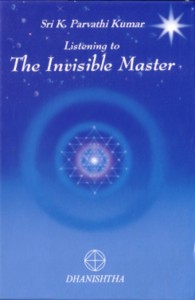Book Presentation
"Listening to the Invisible Master"
by Dr. K. Parvathi Kumar

The human being has layers within layers of existence. As he tunes inward he finds within much
ore than what he things of himself. This booklet reveals a few hidden sides of things relating to the human
being.
This booklet is of interest to those who wish to tune inward, in search of the
unknown. The book takes the reader on a flight into the Internal World and reveals much the phenomenal and
noumenal worlds as one gets into regular practice of meditation.
Multilingual edition,
English, German, French, Spanish, Hebrew
Ediciones Dhanishtha, Barcelona, 1999
ISBN: 84-88011-37-7
Sample:
Listening to the Invisible MasterThe Upanishads describe OM or PRANAVA as the bow and the Truth seeker as the arrow who needs to shoot himself up as much as he can with the help of the bow. The human being is more fond of speaking than listening. The regulations relating to sound postulate that one has to be more a keen listener than a keen speaker. It is said that a keen listener is a good speaker.
“Listen within and then speak out is the instruction to the Yoga student.
“Do not speak without listening”
is yet another instruction.
Listening is the positive side of the sound, and speaking is the negative side of the sound. The negative pole is described in the Scriptures as feminine, and the positive pole is described as masculine. Brihaspathi and Saraswathi are the deities described in the Scriptures as the positive and negative aspects of the sound, meaning the listening and speaking faculties within the being, which need to be harnessed as per the given discipline.
It should be understood that only the one who can listen well can speak well. To start with, listening can be from the objectivity. As one tends more to be a listener than a speaker, he gains the quality of being a good auditor. "Auditors" are welcome into the subtle and Divine World than the lecturers who make noise in the outer. The ability to listen in preference to speaking would in the first step enable one to avoid unnecessary speeches, which only make noise. It also avoids undesirable and unbearable speeches. It further avoids speeches that are critical about others. Finally, one ceases to be judgmental in his speech. These are very important qualities to be gained lf one seeks to walk into the field of listening to the invisible. The discipline relating to the theme therefore demands more listening and less speaking. With such a faculty, when one utters OM, he would also listen to the uttering of OM.
Within, the Sacred Word OM is continuously
being uttered within the being!
As one develops into a keen listener of OM, as he utters and as he carefully and completely listens to the source of OM within him, he would find that the sound is emerging from himself, initially from the vocal cords, but as he carefully retraces the Path to the Source of OM, he reaches the basis of the vocal sound, where he finds that exhalation is the basis for the vocal sound. He further finds that exhalation is again based on inhalation. He realises that inhalation is transforming itself into exhalation, and with exhalation as the basis the sound is uttered forth. Thus the sound is found to be emerging from that point where the inhalation is transforming itself into exhalation while it is gaining the vocal status at the Throat Centre. As one contemplates deeply for long years upon that point in him where inhalation is merging into exhalation, he is drawn into that part which is called the field of pulsation - the birthplace of respiration. That field of pulsation is called HRIDAYAM. HRMAYAM stands for HRIT AYAM, meaning, Here I AM.

 Circle of Good Will
Circle of Good Will Contact
Contact
